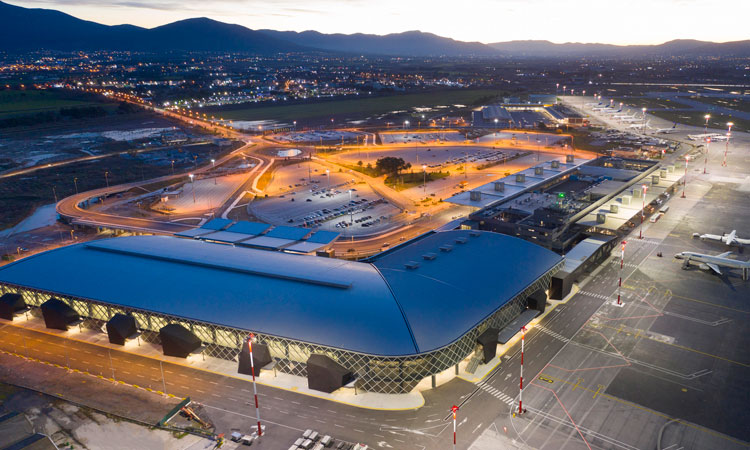Building for the future of aviation
- Like
- Digg
- Del
- Tumblr
- VKontakte
- Buffer
- Love This
- Odnoklassniki
- Meneame
- Blogger
- Amazon
- Yahoo Mail
- Gmail
- AOL
- Newsvine
- HackerNews
- Evernote
- MySpace
- Mail.ru
- Viadeo
- Line
- Comments
- Yummly
- SMS
- Viber
- Telegram
- Subscribe
- Skype
- Facebook Messenger
- Kakao
- LiveJournal
- Yammer
- Edgar
- Fintel
- Mix
- Instapaper
- Copy Link
Posted: 22 December 2021 | Bill Fullerton | No comments yet
Reflecting on the session he moderated at the International Airport Online Summit, Bill Fullerton, Chief Technical Officer of Fraport-Greece, summarises the key discussion points that were raised.


Copyright: Fraport-Greece
When considering how to ‘build for the future’, we inevitably start with the present. We begin by assessing our current challenges considering emerging trends and developments. Our present reality may be an older airport with legacy developments to consider, or a greenfield airport project, starting its development story with a blank page.
For the ‘Building for the Future’ panel of International Airport Review’s flagship summit, we had both: two airport systems, which had recently upgraded their legacy infrastructure under a concession model – Florianopolis Airport in Brazil and the Greek Regional Airports, and the New Heraklion Airport in Crete. Joining these three airport operators for a wide-ranging discussion of future trends was Honeywell’s Global Director for airport building technology.
The COVID-19 crisis
The discussion centred around four main themes: passenger expectations, digitisation, border controls (health protocols and immigrations control), and climate change (both net zero and adaptation programmes). New developments in each of these areas affect the way we ‘build for the future’. And, of course, these new challenges arrive at a time of increasing financial pressure on the aviation industry, due to both the devastating loss of passenger traffic in 2020 resulting from the COVID-19 crisis, and the reduction of long haul and business travel in some sectors.
Passengers today expect to find a smartphone-friendly airport experience, with safe and sanitary terminal touch points, and a commercial offer which reflects the needs of the travelling public – more food and beverage offerings, more local products, more ‘sense of place.’ The IT and mechanical infrastructure needed to create such an environment requires a significant investment, to increase Wi-Fi bandwidth, power enhanced air conditioning systems, and support more full kitchens in the terminal area.
At the same time, airport operators must get more out of their existing spaces. As on-airport check-in becomes the exception rather than the rule, our large check-in halls need to be repurposed to accommodate other needs. Digitisation of passenger flows, using enhanced CCTV systems, passenger counting systems and related technologies, will allow airport operators to optimise passenger throughput, particularly the departures sequence of security, border controls, and gate allocation.
Border control
In Europe, the border control experience for passengers will change significantly with the implementation of the European Entry-Exit System, scheduled for 2022. This system in essence creates another passenger processing point, with its own space and time requirements. Coupled with the process of health screening related to COVID-19, the areas dedicated to border controls will certainly increase, driving the need to reimagine processes and space allocation in our future terminals. Old concepts regarding passenger ‘level of service’ may need to be updated to reflect the new reality.
Climate change
Our last topic addressed climate change. While airports will need to do their part to reduce the carbon footprint, the path to ‘net zero’ is not a short one. It will require both significant energy conservation measures (including energy management systems to optimise the use of electrical power), as well as cogeneration projects to produce clean energy on site. Virtually all airports are developing ‘road maps’ to reduce carbon footprints (many aiming to achieve ACI’s goal of net zero by 2050); some have already reached important reduction milestones. But in the meantime, some airports are already threatened by new climate patterns, requiring adaptive measures to protect critical infrastructure and airside operating surfaces during extreme weather events, such as storms, heatwaves, high winds/waves, and systemic flooding.
All the panellists for the ‘Building for the Future’ discussion offered examples from their airport experience to illustrate the impact of these four challenges. We will briefly look at one such experience here – the new terminal building at Thessaloniki Airport, operated by Fraport-Greece.
As can be seen in the main image, the expansion project involved the construction of a new terminal building (seen in the foreground), connected to the existing terminal building (in the background), which had already been expanded several times in the past.
Building for the future with legacy developments
When airport operators ‘build for the future’ in such cases, they must take into account the legacy development, assessing whether it should be retained (as it was in this case) or demolished and replaced with new infrastructure. Such an assessment should be based on whether the cost of renovation to new standards exceeds the costs associated with new construction. In Thessaloniki (SKG), the results of the assessment showed that the existing building could be adapted and integrated with the new construction in a cost effective and efficient manner.
The resulting expansion project had doubled the capacity of the airport (to over 14 million annual passengers), while at the same time allowing for the implementation of new technologies to support the digitisation of passenger flows, management of energy needs and delivery of a high level of service to passengers and staff.
The participants in the panel discussion ‘Building for the Future’ concurred with the panellists’ assessment of the main future trends confronting the aviation industry. We are all looking to address new passenger expectations and maintain passenger throughput and level-of-service, in the face of challenges stemming from enhanced border controls, new health protocols, and future climate impacts.


As Chief Technical Officer, Fullerton leads a skilled team of engineers and technicians, who recently completed the expansion and refurbishment of the 14 regional airports under concession to Fraport-Greece. Fullerton has over 30 years of leadership experience in the field of transportation projects, including roads and bridges, rail and transit, seaports, and airports. His airport work includes previous assignments with Fraport affiliates worldwide. He was COO of Lima Airport Partners, responsible for operations and development of the Jorge Chavez International Airport, a regional hub in Latin America and winner of multiple industry awards. Other past positions include Chief Development Officer for the Juan Santamaria International Airport in Costa Rica. During his military service, he served as the U.S. Army Engineer for Joint Staff strategic mobility projects worldwide. Fullerton has contributed to the aviation industry as an author, an ICAO and AMPAP instructor, and a leader in organisations related to airport development worldwide. He is a licensed Professional Engineer, an International Airport Professional and a Fellow with the American Society of Civil Engineers. Fullerton holds a PhD in Political Science and a Masters in Civil Engineering from the University of Florida.
Issue
Related topics
Airport construction and design, Airport development, Big data, Border control, Contactless / Touchless technology, COVID-19, Digital transformation, Passenger experience and seamless travel, Passenger volumes, Social responsibility, Sustainability, Sustainable Aviation Fuel (SAF), Sustainable development


















